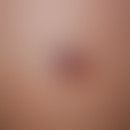Synonym(s)
DefinitionThis section has been translated automatically.
Yellow flowers of arnica.
Arnica flower extract from both Arnica montana and Arnica chamissonis. Arnica flower extract is the starting product of Tinctura arnicae.
Ingredients: essential oils, various fatty acids, terpenes. Fatty acids, terpenes (e.g. azulene), sesquiterterpene lactones (especially helenalin), triterpenes (arnidiol), various types of thymol, paraffin. Thymol types , kerosenes; furthermore coumarins, caffeic acids, choline and flavonoids (astragalin). Sesquiterterpenes
Quality defined in the European Pharmacopoeia (Ph. Eur.):
HMPC monograph: Traditional-use : Bruises, sprains, local muscle pain ("muscle soreness")
ESCOP monograph: External: Bruises, sprains and inflammation due to insect bites; for gingivitis, aphthae; for the symptomatic treatment of rheumatic complaints and muscle pain ("muscle soreness").
Commission E-monograph: External: Consequences of injuries and accidents, e.g. hematomas, sprains, bruises, contusions, fracture edema; rheumatic muscle and joint complaints. Inflammation of the mucous membranes of the mouth and throat; furunculosis and inflammation as a result of insect bites; superficial phlebitis.
Empirical medicine: phlebitis, varicose veins, bruises, injuries, rheumatism, gout, stimulant, also as an abortifacient.
Pharmacodynamics (Effect)This section has been translated automatically.
Antimicrobial and antiphlogistic (mainly due to the sesquiterterpenes) and decongestant effect when applied externally, promotes wound healing. Inhibition of the release of histamine from mast cells, of serotonin from thrombocytes, inhibition of thrombocyte aggregation. Antiseptic, antimycotic, hyperemizing, but: irritating to skin and mucous membranes.
You might also be interested in
IndicationThis section has been translated automatically.
Only externally, always in dilution: Tinctura arnicae can be used for liniments or compresses for blunt trauma, bruises, muscle and joint pain, insect bites, thrombophlebitis, chronic venous insufficiency.
It is not recommended for use on open wounds.
Aphthae: Arnica tincture in a 10% dilution is also recommended for aphthae and non-specific periodontitis.
Internally: not recommended: severe side effects may occur with sweating, gastroenteritis, tachycardia, dyspnoea and even collapse.
Undesirable effectsThis section has been translated automatically.
Contact allergy (as with other Asteraceae extracts), in higher concentrations also toxic contact dermatitis.
ContraindicationThis section has been translated automatically.
Allergy to composite plants,
Pregnancy and lactation, as well as children under 12 years of age in the absence of data
Note(s)This section has been translated automatically.
Ingredients: sesquiterpene lactones (helenaline, dihydrohelenaline), flavonoids, caffeoylquinic acids, polyacetylenes and essential oil.
LiteratureThis section has been translated automatically.
- Hausen BM et al. (1978) The sensitizing capacity of Compositae plants. I. Occupational contact dermatitis from Arnica longifolia Eaton. Contact Dermatitis 4:3-10.
- Jimenez V et al. (2014) Natural sesquiterpene lactones induce programmed cell death in Trypanosoma cruzi: a new therapeutic target? Phytomedicine 21:1411-1418.
- Merfort I (2011)Perspectives on sesquiterpene lactones in inflammation and cancer. Curr Drug Targets 12:1560-1573.
- Usui K et al.(2015) Identification of HSP70-inducing activity in Arnica montana extract and purification and characterization of HSP70-inducers. J Dermatol Sci 78:67-75.
- https://arzneipflanzenlexikon.info/arnika.php
- https://www.ema.europa.eu/en/documents/herbal-monograph/final-community-herbal-monograph-arnica-montana-l-flos_en.pdf
- Wenigmann M. (2017) Phytotherapy medicinal drugs, phytopharmaceuticals, application. Urban & Fischer, p.71-72
- https://www.bundessortenamt.de/bsa/media/Files/BSL/bsl_arznei_2002.pdf
- https://pflanzen.fnr.de/industriepflanzen/arzneipflanzen/pflanzen-datenbank
Blaschek W (2015) Wichtl tea drugs and phytopharmaceuticals. A handbook for practitioners. Wissenschaftliche Verlagsgesellschaft Munich. S 89-93




